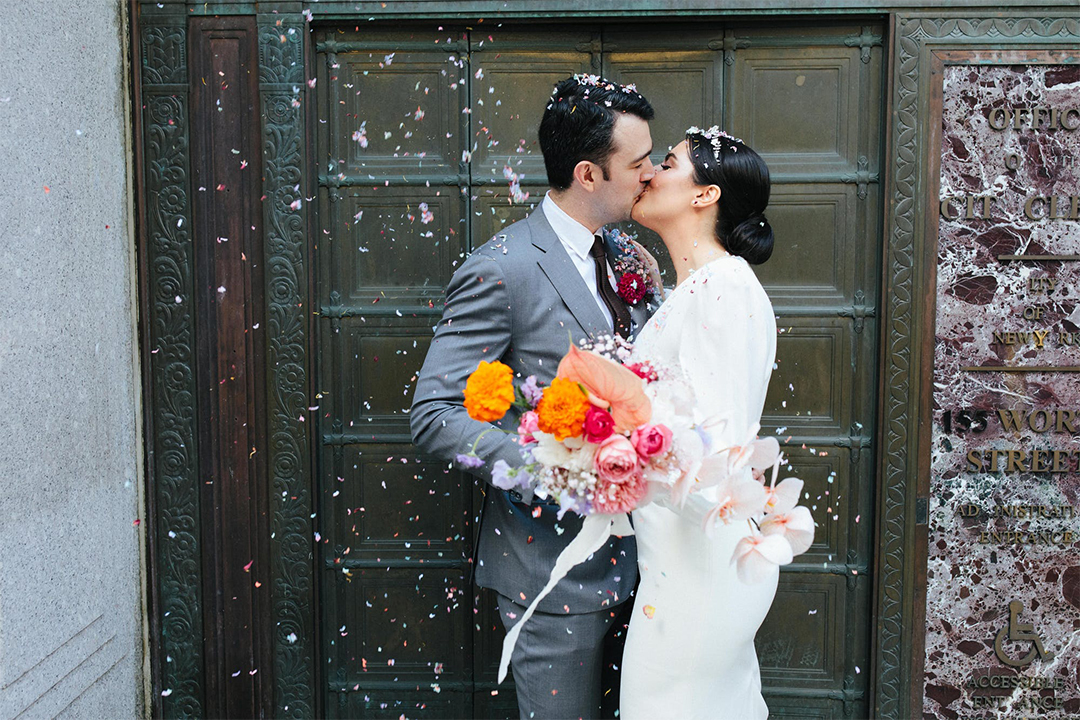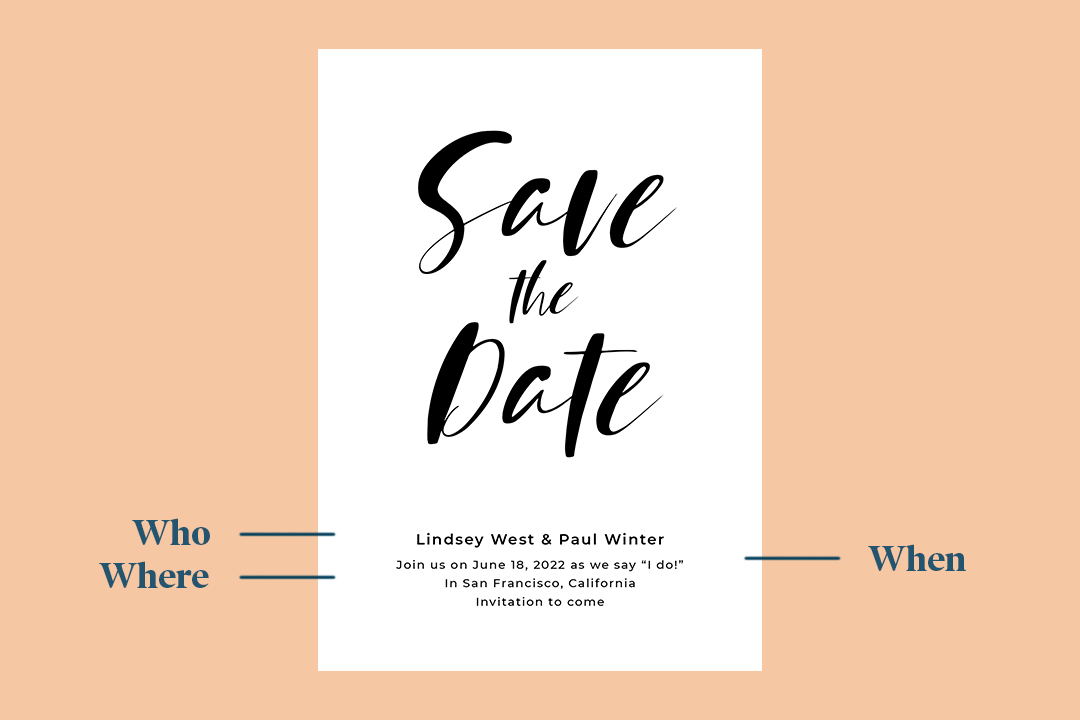- Expert advice/
- Wedding planning 101/
- Wedding planning questions/
- How Many Guests Should I Expect to Come to My Wedding?
- Wedding planning questions
How Many Guests Should I Expect to Come to My Wedding?
There are many factors that determine the average wedding size. One of the biggest ones? The percentage of invited guests that actually attend.
Last updated November 10, 2025

The First Look ✨
- As a rule of thumb, you can usually expect around 75-85 percent of those invited to actually attend the wedding.
- Sending out save the dates seven to ten months in advance will give guests time to prepare for the wedding—ultimately increasing the number of people who will attend.
- The average wedding guest list is more than 100 people. Smaller weddings usually hover around 50 people, while larger celebrations can reach up to 300 or more guests.
- Putting together your perfect guest list is easy at Zola. From stylish wedding invitations to digital seating charts, couples can plan everything with the click of a button.
There are many joys that come with planning your wedding. From selecting the floral arrangements to trying on wedding bands, putting together your big day is full of fun, creative, and important choices.
Then, there’s the guest list. Crafting your wedding guest list can be a source of stress for many couples. How many people should I invite? Can my wedding venue hold this many guests? Is my second cousin’s childhood best friend going to be angry if she’s not invited?
These are just a few of the burning questions soon-to-be spouses ask when putting together their wedding guest list.
On top of making these decisions, there’s also the question of who will even attend the wedding after they receive the invitation. The percentage of guests that actually RSVP can vary depending on the location, date, and time of your wedding.
Fortunately, Zola has you covered. In this article, we’ll be discussing all the variables that go into your wedding guest list, including how many people you should invite and which guests are most likely to show up.
Wedding Guests 101
The simple truth is that not everyone you invite will end up coming to your wedding. Excluding extremely small ceremonies of just the wedding party, usually about 75-85 percent of the people you invite will actually attend your wedding.
Types of Guests
One of the biggest influences on whether or not a guest attends your wedding is their proximity to the location. Generally speaking, there are usually three different types of wedding guests:
-
Local guests – Typically, around 85 percent of local guests will attend your wedding. These are people who live in or around the city where the ceremony is taking place.
-
Out-of-town guests – For many people, a large portion of their list will be out-of-town guests. These guests may not live too far away, but they’ll usually need to stay a couple of nights in order to attend. Couples can expect about 55 percent of out-of-town guests to be present at their wedding.
-
Destination – Finally, we have destination wedding guests. Destination weddings typically require a flight and an extended stay at the wedding location, making it the smallest percentage of the three. Couples should expect about 35 percent of destination wedding guests to attend their big day. That being said, guest lists for destination weddings are often much shorter than a traditional celebration, so this is a factor to keep in mind.
If you’re planning an out-of-town or destination wedding, finding accommodations for guests doesn’t have to be difficult or expensive. Zola users can easily create hotel blocks with our online Hotel Planner—making it possible for all your loved ones to join in on the celebration.
Average Wedding Size
It’s also important to note that the size of a wedding guest list can range quite a bit. While some people prefer to invite only family and wedding party members, others may include their friends and co-workers. The size of your guest list is ultimately up to personal preference, budget, and venue.
Typically most weddings do not have guest lists that exceed 200 people. Most couples today are planning to celebrate with more than 100 or 150 guests.
Beyond this average, every couple will have a different idea of how big they want their wedding to be. Most weddings can be broken down into three categories:
-
Small weddings – Small weddings are great for couples who want an intimate celebration of love. A short guest list can also keep your wedding budget low and leave money for decor, food, and experience. Smaller weddings are typically made up of around 50 people or so.
-
Large weddings – If you have the money and the space, a large wedding can be a blast. Large weddings are also extremely inclusive and allow for all your friends and family to celebrate your big day together. Big weddings may have guest lists as long as 300 people or more.
-
Destination weddings – Did you know that one in four weddings are actually destination weddings? This may surprise many people, but the truth is that destination weddings happen all the time; however, their guest lists are usually pretty exclusive. This is because many people cannot take the time off work or afford the accommodations required for a destination wedding. For these reasons, couples planning a destination wedding will typically keep their guest list small—with an average of 86 people.
Invitation Timeline
Ensuring that a majority of your guests actually show up is all about timing. It’s crucial that couples give their loved ones ample time to prepare for the big day, especially when it comes to guests who are traveling to attend.
The key to preparing your guests for the wedding date is utilizing save the dates.
What Are Save the Dates?
What’s the difference between a wedding invitation and a save the date?
For one, save the dates are more casual. They do not include an RSVP or any detailed information regarding the wedding ceremony and wedding reception. Instead, save the dates are a simple heads up that a wedding is in the works.
Save the dates typically convey three main points:
- The names of the couple
- The city where the wedding is going to be held
- The exact date of the wedding ceremony
Save the dates are a vital step in the wedding process, and you’ll want to send them out around seven to ten months before the wedding date.
When Should Invitations Be Sent?
Wedding Invitations are the more formal side of reserving loved one’s weekends. They typically include an RSVP card (or instructions for a digital RSVP process). Your invitations will also go into greater detail about the following information:
- The exact location of the ceremony
- The time of the ceremony
- Reception information
- Dress code
- Travel information, transportation, and accommodations
Unlike save the dates, invitations are sent out much later—around three to four months before the wedding.
Sending your invitations earlier may seem like a good idea if you want all your guests to attend the wedding; however, this is not typically done. The reason is that many people aren’t able to predict their schedules much further ahead. Additionally, when it’s set too far in advance, many people will forget the wedding is approaching. Plus, that’s what the save the date is for.
Looking for a place to purchase all your wedding stationery? Zola has you covered. We offer hundreds of stylish wedding invitations and save the date designs, and users can even match the two for a perfectly seamless look.
Expectations for Your Guest List
Planning a wedding is a lot of work, and setting realistic expectations is crucial to keeping the process smooth and organized.
Here’s what you need to know about guest list expectations:
-
Be realistic – You’ll want to keep expectations realistic by asking yourself important questions along the way. How many people do you really want there? How many meals can you afford? Which out-of-town guests have the means of traveling to the wedding location?
-
Keep your space in mind – The ceremony and reception venue you select will have a major impact on how long your guest list can be. Consider how many people your venue can hold comfortably and work within these confines. Fortunately, Zola users can check out our database of pre-screened wedding vendors and search for wedding venues based on size. We have options that range from intimate gatherings of 50 people to large celebrations of 300 or more.
-
Don’t be offended – When crafting your guest list and sifting through RSVPs, it’s important to not let emotions get out of control. Planning a wedding can be stressful, and finding out a loved one can’t come never feels good. That being said, couples should keep in mind that people have busy lives, and some loved ones may not be able to travel at this time. Always remember that your friends and family still love you even if they’re unable to attend the wedding.
Creating Your Guest List
So we’ve covered the main question at hand: what percentage of people will attend your wedding, but where do you go from here? Gauging how many people will RSVP to your wedding is important because it will help you craft the best guest list possible.
Most couples start by creating their own individual lists and then combining them for a final tally. Here’s how to do this, step-by-step:
-
Step 1: Your immediate family – You’ll want to begin your guest list with the immediate family members who will be attending the wedding—this includes parents, siblings, and in-laws.
-
Step 2: Wedding party members – By this point, you’ve probably already chosen your wedding party members (ie. best man, best maiden, maid of honor, man of honor, etc.)—so including these guests on your list will be pretty easy. Most wedding parties are typically no larger than 10 people, with five members on each side.
-
Step 3: Extended family – Next, consider how many extended family members you’ll want to invite. This list includes grandparents, cousins, aunts, uncles, and perhaps any close family friends. This step will often take up a large portion of your guest list, since many people have large extended families.
-
Step 4: Close and mutual friends – Next, you have all the friends who are not part of the wedding party. Think about your friends in terms of groups and go through your list thoroughly to make sure that you haven’t forgotten anyone important. You and your fiance can also compare lists when it comes to mutual friends, in order to avoid sending out double invites by accident.
-
Step 5: Co-workers – Do you have any colleagues from work that you’d like to invite? If you have the space on your guest list, now is the time to include them. The same goes for colleagues from any previous jobs that you’ve had who you remained friends with.
-
Step 6: Spouses and significant others – Traditionally, it’s common courtesy to invite the spouses and partners of any of your guests. As far as new romantic relationships go, there is no cut-and-dry etiquette for invitations, but it’s always polite to give adult guests a plus one.
-
Step 7: Children – If you’re inviting the parents of a young child, it’s a nice gesture to invite their children too. That being said, some couples may prefer to have a child-free wedding, and this practice is fairly common. Sometimes, parents are excited for a night to themselves—in this case, we recommend giving people a heads up so that they can find a babysitter.
-
Step 8: Guests of parents – If parents are contributing money to the wedding, it's customary for them to add their own guests to the list—this goes for your spouse’s parents, too.
-
Step 9: Out-of-town guests – For couples with close friends and family who live far away, it’s traditional to send out an invitation to them regardless of whether or not they can come. Not only is this the polite thing to do, but it also leaves room for a pleasant surprise if they actually can make it.
-
Step 10: Plus ones – Although we briefly touched upon this subject in step six, plus ones are crucial to keep in mind when crafting your guest list. If you’re allowing a guest to bring a plus one, this must be stated on the invitation. If not explicitly stated, this usually means a plus one is not expected. Not being specific about plus-ones can lead to problems with seating, so just be sure to make this as clear as possible. Traditionally, single adults are allowed plus ones, while younger guests are not. Plus-ones can be a sensitive subject, since most people do not want to attend a wedding alone. This is why it's important to remain considerate when determining the plus one rule for your wedding day.
You and your fiance will each make your own list, and then compare at the end. While these lists should be relatively equal, the final number is ultimately up to you. If you tend to keep your circle tight, and your spouse is more of a social butterfly, there’s nothing wrong with them having a few more guests on their list. Just remember to communicate and make sure that you’re on the same page every step of the way.
Building Your Seating Chart
After you’ve finalized the guest list, it’s time to move on to the seating chart.
Generally, weddings of over 50 people will need a seating chart to keep things organized. Here are some basic tips you’ll want to keep in mind when crafting this essential part of your wedding day:
-
Choose tables wisely – You’ll want to spend a good amount of time figuring out who will sit together at each table. Usually, wedding party members sit together with the happy couple. Families will also typically sit together, often sectioned off by immediate family or sides of the family. The parents of the couple may sit together or with their own family members, depending on their relationship to each other. Friends from the same groups—such as high school friends, college friends, and co-workers—will usually sit together, too.
-
Kids table – If you do choose to invite kids, you’ll probably have a designated kids table. Most weddings only have a single kids table, since a majority of guests will be adults.
-
Surprise guests – Sometimes, you get a few surprise arrivals on your wedding day. This may be due to a lost RSVP in the mail, or an unexpected plus one brought by a guest. It’s important to have a few extra chairs on hand just in case an additional guest arrives.
With Zola's Wedding seating chart, you can seat all your guests in minutes.
How Many People Should Sit at Each Table?
The number of guests at each table will depend on your venue and layout, but large circular tables can usually fit around eight to 12 people comfortably.
Some couples may opt for longer, rectangular tables to create a family-style dining experience. These types of tables are able to fit a larger number of people and may work better for more intimate gatherings by allowing all your guests to sit together.
Putting together a seating chart on paper can be complicated and time-consuming. That’s why many couples are ditching the cork boards and thumbtacks for Zola’s online guest list manager. Users can create organized seating charts directly on our website and save them for later.
Plan Your Perfect Guest List at Zola
Wedding planning can be complicated, but it doesn’t have to be when you use Zola.
Zola is your one-stop shop for all your nuptial necessities: from helpful planning tools—like our vendor database and online guest manager—to stylish invitation designs, and even Expert Wedding Advice. Once you start putting together your big day from the comfort of home, you’ll be able to ditch the stress and jump straight to the celebration.
Start planning your wedding the modern way today, at Zola!
Up next for you

10 Tips to Pick the Perfect Wedding Venue
How-To
How does one go about choosing a wedding venue? Here's the rundown on one of the first tasks you’ll need to accomplish after saying “yes!”

What to Look for in Your Wedding Venue Contract
Inspiration
Wondering what you should check for in your wedding venue contract? We're here to help! So, continue reading to learn more about it.

All-Inclusive Wedding Venues: Pros and Cons
Advice
All-inclusive wedding venues provide essential services, thus reducing your need to vet and book wedding vendors. Is all-inclusive right for you? Find out here.

2024/25 Printable Wedding Planning Checklist & Timeline - Zola
Don’t miss a wedding planning detail with our complete, expert-crafted wedding checklist and timeline. Free, printable version inside!
Featured

How Much to Tip Wedding Photographers
Advice
Navigate wedding photographer tipping etiquette effortlessly. Discover guidelines and advice on how much to tip to show appreciation for their exceptional work.

A Guide to Save The Dates
Inspiration
Save the dates add an extra touch of style and coordination to your wedding. Find out why and when you should send your save the dates with this complete guide.

How to Write a Wedding Toast: The Ultimate Guide
How-To
Wedding toasts are tricky. We’ve got some helpful tips to guide you towards a great wedding toast that you and your favorite couple will remember fondly for years, so grab your notepads and get ready for some key(note) advice.

How to Handle a Super Drunk Wedding Guest
How-To
Weddings are celebrations and things can get out of hand. Here's exactly how to deal with drunk wedding guests (and even prevent too much over-drinking).
- Expert advice/
- Wedding planning 101/
- Wedding planning questions/
- How Many Guests Should I Expect to Come to My Wedding?
Find even more wedding ideas, inspo, tips, and tricks
We’ve got wedding planning advice on everything from save the dates to wedding cakes.
